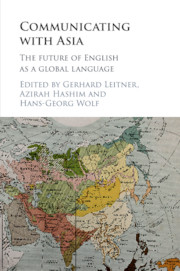Book contents
- Communicating with Asia
- Communicating with Asia
- Copyright page
- Contents
- Figures
- Tables
- Contributors
- Book part
- Communicating with Asia: introduction
- Part I English in selected regional and national habitats with a glance at the role of outward-bound communication needs
- Part II Major other languages in Asia, their international status and impact on education
- Part III Wider perspectives
- 16 Understanding Asia by means of cognitive sociolinguistics and cultural linguistics – the example of ghosts in Hong Kong English
- 17 Understanding Asia through English literature
- 18 English as a lingua franca and educational impact in Asia
- 19 The Australian Asia project
- Bibliography
- Index
18 - English as a lingua franca and educational impact in Asia
from Part III - Wider perspectives
Published online by Cambridge University Press: 05 January 2016
- Communicating with Asia
- Communicating with Asia
- Copyright page
- Contents
- Figures
- Tables
- Contributors
- Book part
- Communicating with Asia: introduction
- Part I English in selected regional and national habitats with a glance at the role of outward-bound communication needs
- Part II Major other languages in Asia, their international status and impact on education
- Part III Wider perspectives
- 16 Understanding Asia by means of cognitive sociolinguistics and cultural linguistics – the example of ghosts in Hong Kong English
- 17 Understanding Asia through English literature
- 18 English as a lingua franca and educational impact in Asia
- 19 The Australian Asia project
- Bibliography
- Index
Summary
This chapter will begin with a brief historical review of languages which have operated as lingua francas across East and Southeast Asia. It will then review the development of English in selected Asian countries and its role in those countries today. It will be argued that the role of English in Asia has now extended beyond operating at intranational level, as evidenced by the existence of established varieties of English such as Malaysian and Filipino, to becoming an interregional lingua franca. That is to say, a major Asian role of English is as a medium of interregional communication for Asian multilinguals for whom English is an additional language. Evidence for this comes, for example, from the legislation of English as the sole working language of the ten countries which make up the Association of Southeast Asian Nations (ASEAN). Drawing on research based on a study of which languages are currently being used as languages of education in school curricula in selected Asian countries, using the Philippines and Indonesia as case studies, the chapter will consider the educational impacts of the role of English as a lingua franca in Asia. This section of the chapter will include tentative predictions for the respective roles of English and Asian languages. The chapter will conclude with suggestions for a ‘Communicating with Asia’ skill-set which Europeans might find useful.
- Type
- Chapter
- Information
- Communicating with AsiaThe Future of English as a Global Language, pp. 282 - 295Publisher: Cambridge University PressPrint publication year: 2016
- 3
- Cited by

